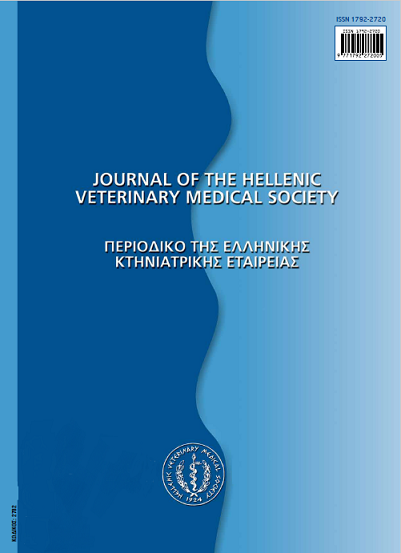Φαρμακοκινηχικη μελέτη της χλωραμφενικόλης (CAP) στην τσίπουρα (Sparus aurata) και in vitro δράση κατά σημαντικών για τα ψάρια παθογόνων βακτηρίων

Περίληψη
Στη μελέτη αυτή διερευνήθηκαν οι φαρμακοκινητικές ιδιότητες της χλωραμφενικόλης (CAP) στην τσίπουρα {Sparus aurata) και η in vitro αποτελεσματικότητα της κατά των διαφόρων βακτηριακών ασθενειών. Μετά από ενδοφλέβια χορήγηση της CAP στη δόση των 10 mg/kg/ψάρι, ο χρόνος ημίσειας ζωής της κατανομής (t1/2α ) και ο χρόνος ημίσειας ζωής της απομάκρυνσης (t1/2β) βρέθηκαν ότι είναι 1.6 και 69h, αντίστοιχα. Η διάχυση της CAP στους ιστούς της τσιπούρας ήταν μέτρια εφόσον αμφότεροι, τόσο ο φαινομενικός όγκος κατανομής (Vd(ss)) όσο καιο φαινομενικός όγκος του κεντρικού διαμερίσματος (Vc), υπολογίσθηκαν σε 1,13 και 0,90 L/kg. Η ολική σωματική απομάκρυνση (CLT) της CAP ήταν βραδεία (0,022 L/kg/h). Οι τιμή MIC της CAP σε απεσταγμένο νερό με προσθήκη 2% NaCl κατά των Vibrioanguillarum ορότυπος lb, Photobacterium damsela subsp.piscicida, V. alginolyticus και Vßuvialis υπολογίσθηκε σε 4,78μg/mL, ενώ ήταν 0,60 μg/mL για το V damsela. Η προσθήκη στο υπόστρωμα 10 mM Ca2+ και 55 mM Mg2+ έδωσε τιμές MIC 19,13μg/mL για το V alginolyticus και το V tluvialis, ενώ δεν παρατηρήθηκε κάποιο αποτέλεσμα με το V. anguillarum P. damsela subsp.Piscicida και το V. damsela. Τα αποτελέσματα αυτά έδειξαν ότι η CAP παρουσιάζει μια ικανοποιητική εικόνα κινητικής και ότι απομακρύνεται γρήγορα από τη σάρκα της τσιπούρας, ενώ οι υψηλές τιμές MIC δείχνουν μια πιθανή αναποτελεσματικότητα ενάντια σημαντικών παθογόνων βακτηρίων στα ψάρια της Μεσογείου.
Λεπτομέρειες άρθρου
- Πώς να δημιουργήσετε Αναφορές
-
TYRPENOU (Α.Ε. ΤΥΡΠΕΝΟΥ) A. E., RIGOS (Γ. ΡΗΓΟΣ) G., YAGNISI (Μ. ΓΙΑΓΝΙΣΗ) M., NENGAS (Ι. ΝΕΓΚΑΣ) I., & ALEXIS (Μ. ΑΛΕΞΗΣ) M. (2017). Φαρμακοκινηχικη μελέτη της χλωραμφενικόλης (CAP) στην τσίπουρα (Sparus aurata) και in vitro δράση κατά σημαντικών για τα ψάρια παθογόνων βακτηρίων. Περιοδικό της Ελληνικής Κτηνιατρικής Εταιρείας, 54(4), 311–320. https://doi.org/10.12681/jhvms.15340
- Τεύχος
- Τόμ. 54 Αρ. 4 (2003)
- Ενότητα
- Research Articles
Οι συγγραφείς των άρθρων που δημοσιεύονται στο περιοδικό διατηρούν τα δικαιώματα πνευματικής ιδιοκτησίας επί των άρθρων τους, δίνοντας στο περιοδικό το δικαίωμα της πρώτης δημοσίευσης.
Άρθρα που δημοσιεύονται στο περιοδικό διατίθενται με άδεια Creative Commons 4.0 Non Commercial και σύμφωνα με την άδεια μπορούν να χρησιμοποιούνται ελεύθερα, με αναφορά στο/στη συγγραφέα και στην πρώτη δημοσίευση για μη κερδοσκοπικούς σκοπούς.
Οι συγγραφείς μπορούν να καταθέσουν το άρθρο σε ιδρυματικό ή άλλο αποθετήριο ή/και να το δημοσιεύσουν σε άλλη έκδοση, με υποχρεωτική την αναφορά πρώτης δημοσίευσης στο J Hellenic Vet Med Soc
Οι συγγραφείς ενθαρρύνονται να καταθέσουν σε αποθετήριο ή να δημοσιεύσουν την εργασία τους στο διαδίκτυο πριν ή κατά τη διαδικασία υποβολής και αξιολόγησής της.





